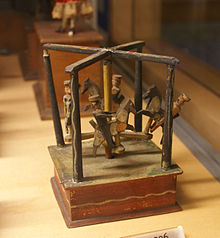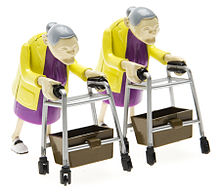- Mechanical toy
-
Mechanical toys are powered by mechanical energy, for example using rubber bands, springs, and flywheels. Mechanical toys use four types of different movements, these are called Rotary (going around in a circle, can be clockwise and anticlockwise), Linear (moving in a straight line then stopping), Reciprocating (moving backwards and forwards continuously in a straight line) and Oscillating (moving backwards and forwards in a curve).
Contents
Types of mechanical toys
Depending on the mechanism there are several types of mechanical toys:
Cam toys are powered by a cam and cam follower which transfers the cam rotation to the working area of the toy. The cam is unevenly rotated by placing the rotator out of the ideal center. This transforms the circular motion into motion that moves up and powers the toy.
Crank toys are internally based on cams too but allow more complicated motions. Single rotation of the crank leads to single action in the working area of the toy, and moving the crank forward and backward can result in reversed motion.
Gear toys use gear wheels to transfer the power in the toy, to change the speed and direction of motion. They can be powered by hand (with a cram or cam and cam follower) or by wind-up mechanism. The different number of teeth in the gear wheels determine the speed transition from wheel to wheel. By chaining and distributing number of gear wheels this type of mechanical toys allows very complex motions.
Lever toys are mechanical toys that use the mechanical advantage of lever to transmit and transform movement. Level toys can use cranks and cams too.
Pulley toys. Pulleys are very similar to gear wheels but two elements are connected by a metal chain or belt from elastic strong material (for example rubber). Pulleys allow transferring power on distance much easier and with less losses that using number of gear wheels. Using pulleys in mechanical toys also allows to change the angle, the speed and the direction of the motion.
Wind-up toys typically are powered by a metal spring that is tightened by turning it. Then gear wheels and pulleys can transfer the power and control the toy motion.
History of mechanical toys
One of the first mechanical toys is the flying pigeon by Archytas of Tarentum created 400 years BC. In 16th Century Leonardo da Vinci created his mechanical lion as a present for king Louis XII. The lion could walk and reveal a cluster of lilies from his chest. In 1738 Jacques de Vaucanson created a mechanical robot duck that was able to drink and eat. Pierre Jaquet-Doz created The Writer, The Draftsman and The Musician - toys that are still present in the museum of Art and History in Switzerland. Wind up toys date far back into history, into the 15th century.
See also
External links
Wikipedia
Categories:- Mechanical toys
Wikimedia Foundation. 2010.


